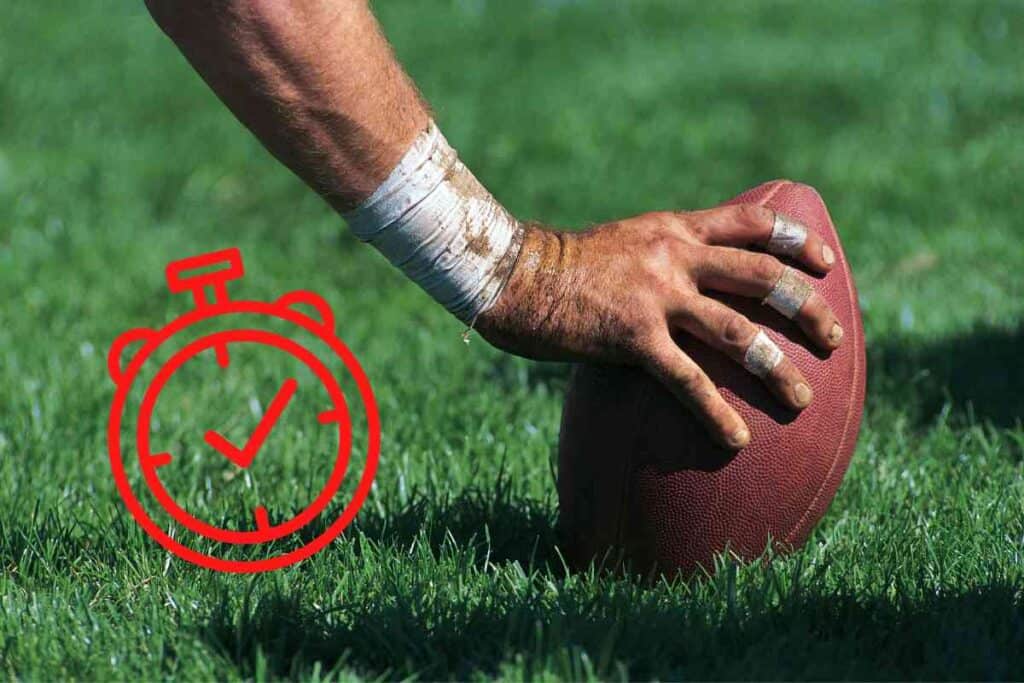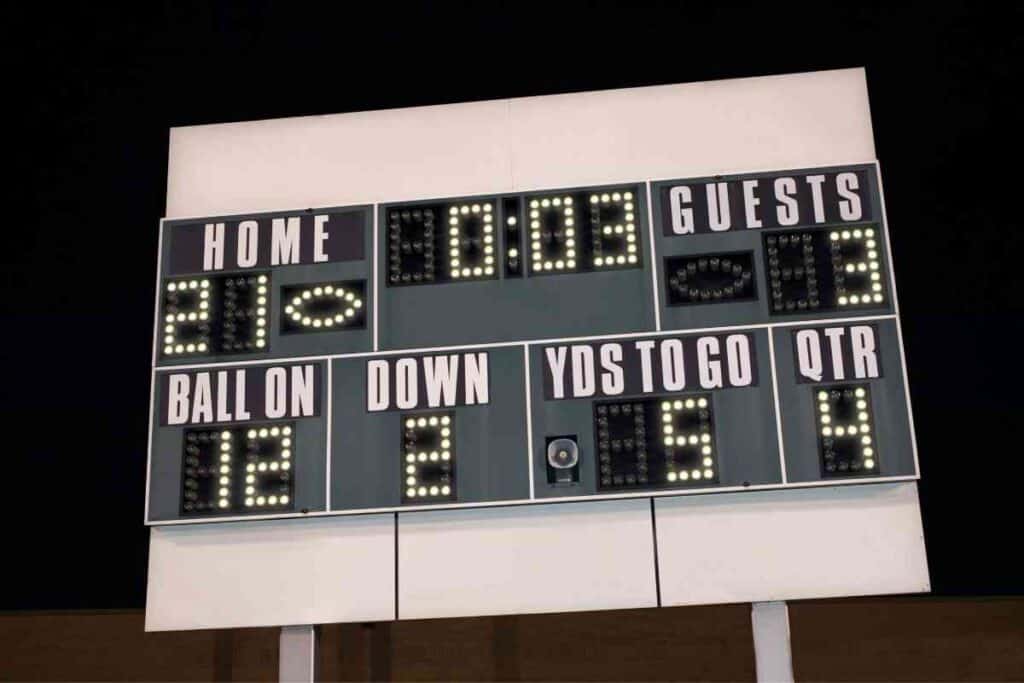High School Football 101: Understanding The Play Clock
High school football may seem like it’s the same as college football or the NFL. But does high school football have a play clock?

Does high school football have a play clock?
Yes, high school football does have a play clock. The play clock is standard like any other level of football. The play clock starts 40 seconds after the previous play ends. If the offense fails to snap the football before the play clock hits zero, they are charged with a delay of game.
As a former high school football team member, I can attest to the fact that all high school football games have a play clock.
A high school football game could not be complete without the clock, since time could not be kept. The play clock in high school football is vital to the operation of the game.
What Is A Play Clock In Football?
A play clock in football is a timer to keep the game in motion. Without the play clock, time taken between plays could be substantial. The play clock sets a timer on the time taken between plays, in order to keep the game going.
The play clock is a timer that starts down from 40 seconds after the previous play has stopped. If the offense fails to snap the ball in the time frame of 40 seconds, a delay of game is called which results in a penalty, which is a 5 yard penalty.
The play clock helps the game continue to move forward at a steady pace without extra delays from the offensive team.
Does High School Football Use A Play Clock?

Yes, high school football does use a play clock. This is because, just like in college and pro football, there is a need to keep the game moving forward at a steady pace.
Especially at the high school level, where plays and play calling can become quite unorganized, a play clock is needed to ensure the offense doesn’t hog the ball and turn one possession into a 20 minute ordeal.
The NFHS sets the rules and regulations for high school football, including the use of a play clock. The play clock in high school football is the same as the play clock in college and pro football, which is 40 seconds.
This play clock time ensures high school players are exposed to the same rules that college and pro players play by.
When is the Play Clock Set to 25 Seconds
Administrative stoppages are a regular occurrence in high school football, and they give the offense a smaller window to snap the ball and execute their play. There are a number of different situations that can result in an administrative stoppage, such as:
- Charged Timeout
- End of Quarter
- Punt
- Change of Possession
- Penalty
- Extra Point on a 2-Point Conversion Attempt
- Two-minute Warning

What is a 10-Second Run-Off?
When playing high school football, time is of the essence. Each second counts and can make or break a team’s victory on the field.
A key thing to keep in mind when playing ball is that penalties and violations can result in a 10-second run-off that can affect both teams. Once a 2-minute warning has been declared, a 10-second run-off can happen if either of the teams breaks specific rules while the clock is running, such as:
- Intentional grounding
- Throwing a pass backward out of bounds
- Spiking or throwing the ball in the field after the down is over (except for touchdowns)
- Offensive fouls that interfere with the snap
- Illegal forward passes past the line of scrimmage
Any of these violations will result in the clock being set back 10 seconds. The team that did not violate regulations will be given the choice of whether the clock is set back 10 seconds.
If running out the clock is in the best interests of the team, they will agree to the 10-second run-off.
Why is the Play Clock Important in High School Football?
The play clock serves several different purposes in high school football. The first purpose that the play clock serves is, it helps keep the game moving at a steady pace.
This is important because it prevents the game from stalling due to unorganized play calling.
Secondly, it helps prevent teams from exploiting the time by using time-wasting tricks in order to keep possession of the ball longer.
Since ball possession time is directly linked with victory, the play clock measure ensures one team cannot keep the ball for an excessive amount of time.
Lastly, the play clock helps prepare high school football students for levels of play that they may face in coming years.
For example, a freshman in high school with four years of running plays under the pressure of a play clock will be a much better player when they move on to college football than a player who has not had to deal with a play clock.
The play clock is a crucial component of high school football games. The state high school associations set the rules for the clock as well as the national federation.
The play clock is an important tool that helps to ensure the integrity and competitiveness of high school football games.

High School Student Athletes
High school student athletes are very competitive. If they wish to compete at higher levels, they need to be exposed to pro level conditions. For example, if they abuse the play clock, they need to be hit with a penalty flag, just like any other sport.
While some think there should be a rule change in high school football regarding the play clock, lots disagree.
Some think the 40 second play clock is enough to keep the students playing at a good enough rate in order to keep the game fair. In order to force a clock stop, students must use measures like those in the pros do.
Game officials will penalize delays of games in high school just as often as they do in college and pro sports. When an incomplete pass is thrown, a clock stop will occur.
Another way to stop the clock in high school football is to wait for the two minute warning. In high school football, there is a two minute warning that happens just before the end of each half, which stops the clock.
High school student athletes that play by these rules are being prepared for higher levels of playing sports. This is good for them, since when they arrive at the next level of competition, they will be familiar with the rules of play.
How Often Are Delay of Game Penalties Called?
The frequency of delay of game penalties depends on the teams playing, the level of the teams playing, and the individual officials overseeing the game. Delay of game penalties are called when the offense fails to snap the ball within 40 seconds of the play clock.

The delay of game penalty that results in moving the ball back five yards for the team on offense. For the NFL, every team has about 3.84 delay of game penalties called on them for each season.
That means each team in the NFL fails to snap the ball within 40 seconds of the play clock, resulting in a delay of game penalty.
In 2020, Houston had the most delay of game penalties, by having 8 delay of game penalties called against them. These penalties resulted in a loss of 40 yards for the year.
Delay of game penalties can be costly, and as is the case in Houston, shows a disorganized offensive coordinator.

How Does the Play Clock Work in the NFL?
The play clock in the NFL works very similarly to high school football. Most of the rules applied to the play clock are consistent across the board to both leagues of the sport, and players need to adhere to the 40 and 25-second countdowns for their plays.
However, a distinction between NFL and high school football is that professional NFL games have longer quarters. Instead of 12 minutes quarters like in high school football, the NFL has 15-minute quarters.
The extended quarter time in NFL football adds exactly 12 minutes to the total clock time of the game. While this may not seem like a lot, the difference can amount to as much as an extra hour to 1.5 hours of total game time.
Key Takeaways
- High school football does use a play clock.
- The play clock starts at 40 seconds after the previous play has stopped.
- The play clock exposes high school players to higher levels of play.
- The play clock is important to keep the game running forward smoothly.
- Each team in the NFL has about 4 delay of game penalties called on them each season.
